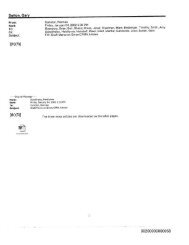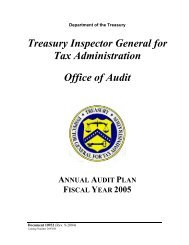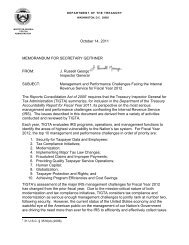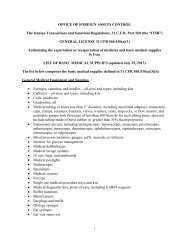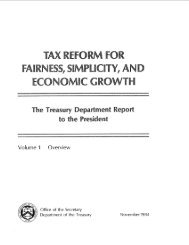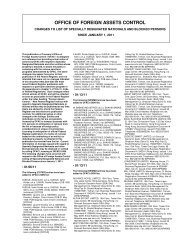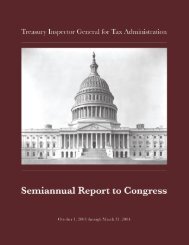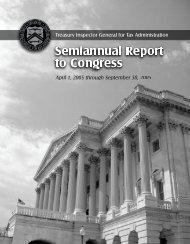Other Curtailment of Tax Shelters - Chap 16, Vol 2, Tax Reform ...
Other Curtailment of Tax Shelters - Chap 16, Vol 2, Tax Reform ...
Other Curtailment of Tax Shelters - Chap 16, Vol 2, Tax Reform ...
You also want an ePaper? Increase the reach of your titles
YUMPU automatically turns print PDFs into web optimized ePapers that Google loves.
CHAPTER <strong>16</strong><br />
OTHER CURTAILMENT OF TAX SHELTERS<br />
Current rules limiting the deduction <strong>of</strong> investment interest are<br />
inadequate to curtail tax shelter abuses. This <strong>Chap</strong>ter proposes a<br />
comprehensive limitation on the deduction <strong>of</strong> nonbusiness interest. In<br />
addition, the special exceptions to the at-risk limitations for<br />
certain leasing and real estate activities would be repealed, so that<br />
the at-risk rules would apply uniformly to all activities.<br />
- 330 -
Current Law<br />
LIMIT INTEREST DEDUCTIONS<br />
General Explanation<br />
<strong>Chap</strong>ter <strong>16</strong>.01<br />
In general, interest paid or incurred on indebtedness is fully<br />
deductible from income. This general rule is subject to exceptions<br />
for- interest on indebtedness incurred to generate certain taxpreferred<br />
income. Thus, for taxpayers other than certain financial<br />
institutions, no deduction is allowed for interest on indebtedness<br />
incurred to purchase or carry obligations which generate tax-exempt<br />
income, In addition, for noncorporate taxpayers, interest on debt<br />
incurred to acquire or carry investment property ("investment<br />
interest") is deductible only to the extent <strong>of</strong> the sum <strong>of</strong> (i) $l0,000<br />
($5,000 for married persons filing separately), (ii) "net investment<br />
income," and (iii) certain deductions attributable to net-leased<br />
property. Amounts disallowed under this limitation for a taxable year<br />
are carried forward and treated as investment interest in the<br />
succeeding taxable year.<br />
Interest on debt incurred to acquire or carry personal-use<br />
property or business property is ordinarily deductible currently, even<br />
if that property does not produce taxable income or is likely to<br />
appreciate substantially (resulting in deferred capital gains). (See<br />
Ch. 10.01 for a discussion <strong>of</strong> circumstances in which interest costs<br />
must be capitalized when incurred in connection with certain<br />
production or manufacturing activities.)<br />
Reasons for Change<br />
Clear reflection <strong>of</strong> income for tax purposes requires that the<br />
costs <strong>of</strong> generating income be matched with the income actually earned.<br />
If a current deduction is allowed for the cost <strong>of</strong> producing income<br />
that is exempt from tax or includible in income on a deferred basis,<br />
the current deduction will <strong>of</strong>fset other taxable income and thus<br />
eliminate or defer tax. Such "tax arbitrage" occurs, for example,<br />
when an investor deducts interest on indebtedness incurred to acquire<br />
or carry assets that yield tax-exempt income such as personal-use<br />
property or assets held in an Individual Retirement Account. It also<br />
occurs, though with less predictability, where indebtedness is<br />
incurred to acquire or carry interests in busi.ness property that<br />
experiences real appreciation over time.<br />
Cu.rrent law permits taxpayers to deduct the interest costs <strong>of</strong><br />
generating certain tax-exempt or tax-deferred income. Although<br />
interest incurred to acquire or carry tax-exempt bonds is<br />
nondeductible, interest incurred to produce analogous forms <strong>of</strong><br />
- 331 -
tax-preferred income is deductible without limitation. Thus,<br />
“consumer interest,” i.e., interest incurred to acquire personal<br />
assets, such as a car or vacation home, is fully deductible, even<br />
though such assets do not generate taxable income. Similarly, current<br />
law limits the deductibility <strong>of</strong> “investment interest,” but interest<br />
incurred in a trade or business is fully deductible, even if the<br />
investor is not actively engaged in the management <strong>of</strong> the business and<br />
much <strong>of</strong> the return from the business is expected to be in the form <strong>of</strong><br />
deferred capital gains. This current deductibility <strong>of</strong> interest is an<br />
important feature <strong>of</strong> real estate tax shelter investments structured as<br />
limited partnerships.<br />
The unlimited deduction for consumer and “passive“ business<br />
interest also undermines existing limitations on investment interest<br />
and interest incurred to acquire tax--exempt bonds. Since money is<br />
fungible, the identification required under current law <strong>of</strong> the purpose<br />
for which indebtedness is incurred is difficult at best. The general<br />
deductibility <strong>of</strong> all consumer and business interest complicates the<br />
task <strong>of</strong> determining whether debt was incurred for a nondeductible<br />
purpose.<br />
Proposal<br />
Interest subject to the current investment interest limitation<br />
would be expanded to include: (a) all interest not incurred in<br />
connection with a trade or business (other than interest on debt<br />
secured by the taxpayer‘s principal residence, to the extent such debt<br />
does not exceed the fair market value <strong>of</strong> the residence), (b) the<br />
taxpayer’s share <strong>of</strong> all interest expense <strong>of</strong> S corporations (other than<br />
S corporations in which the taxpayer actively participates in<br />
management), and (c) the taxpayer’s distributive share <strong>of</strong> all interest<br />
expense <strong>of</strong> limited partnerships in which the taxpayer is a limited<br />
partner. Interest on indebtedness incurred to carry or acquire<br />
business rental property used by the taxpayer for personal purposes<br />
for part <strong>of</strong> a taxable year would generally be treated as business<br />
interest (and thus not subject to limitation) in the same proportion<br />
that the number <strong>of</strong> days the property is rented at a fair rental bears<br />
to the number <strong>of</strong> days in the taxable year.<br />
Interest subject to the limitation would be deductible only to the<br />
extent <strong>of</strong> the sum <strong>of</strong> (a) $5,000 ($2,500 in the case <strong>of</strong> a married<br />
person filing a separate return), and (b) the taxpayer‘s net<br />
investment income. In general, net investment income for this purpose<br />
would have the same meaning as under current law, except that it would<br />
include the taxpayer’s share <strong>of</strong> all income <strong>of</strong> S corporations not<br />
managed by the taxpayer, and the taxpayer’s distributive share <strong>of</strong> all<br />
income <strong>of</strong> limited partnerships in which the taxpayer is a limited<br />
partner. Any interest deduction disallowed for the taxable year under<br />
this limitation would be treated as investment interest expense for<br />
the succeeding taxable year.<br />
In general, interest income and expense would be adjusted by<br />
application <strong>of</strong> the fractional exclusion rate (see Ch. 9.03) prior to<br />
- 332 -
application <strong>of</strong> the investment interest limitation. Suspended interest<br />
deductible in a succeeding taxable year would not be subject to<br />
further adjustment by the fractional exclusion rate. If interest<br />
subject to the limitation includes both itemized and nonitemized<br />
interest expense deductions, suspended interest would first reduce the<br />
current deduction for nonitemized interest expense to the extent<br />
there<strong>of</strong>, and the current deduction for itemized interest expense to<br />
the extent <strong>of</strong> any excess. Suspended interest deductions subsequently<br />
allowed would first be treated as itemized interest expense, to the<br />
extent <strong>of</strong> suspended itemized interest deductions, and nonitemized<br />
interest expense to the extent <strong>of</strong> the excess.<br />
Effective Date<br />
The proposal would be effective for interest expense paid or<br />
incurred in taxable years beginning on or after January 1, 1986. The<br />
expanded limitation would be phased in so that for taxable years<br />
beginning before January 1, 1980, interest subject to limitation would<br />
be deductible to the extent <strong>of</strong> $10,000 plus net investment income.<br />
Analysis<br />
Because the expanded limitation on interest deductions would not<br />
apply to mortgage interest deductions on the taxpayer's principal<br />
residence nor to the first $5,000 <strong>of</strong> any additional interest expense,<br />
the vast majority <strong>of</strong> taxpayers would not be affected by the proposal.<br />
Interest expenses attributable to a trade or business in which the<br />
taxpayer actively participates also would not be subject to the<br />
limitation. Thus, sole proprietors, owner-operators <strong>of</strong> farms, general<br />
partners, and shareholder-managers <strong>of</strong> S corporations would continue to<br />
treat their business expenses in the same manner as under current law.<br />
However, taxpayers with substantial tax shelter interest expense would<br />
be prevented, in many cases, from using that interest expense to<br />
<strong>of</strong>fset business and employment income.<br />
- 333 -<br />
459-813 0 - 84 - 12
Current Law<br />
EXTEND AT-RISK LIMITATION TO ALL ACTIVITIES<br />
General Explanation<br />
<strong>Chap</strong>ter <strong>16</strong>.02<br />
In general, current law limits the loss a taxpayer may deduct<br />
from an investment to the amount the taxpayer has at-risk with<br />
respect to such investment. This "at-risk" limitation on<br />
deductible losses applies to individuals and to certain closely<br />
held corporations, and is applied on an "activity-by-activity"<br />
basis.<br />
For purposes <strong>of</strong> the at-risk rules, a taxpayer is generally<br />
at-risk in an activity to the extent that the taxpayer has<br />
contributed money or property (to the extent <strong>of</strong> its basis) to the<br />
activity, or is personally liable to repay borrowed funds used in<br />
the activity. A taxpayer is not considered to be at-risk with<br />
respect to amounts protected against loss through nonrecourse<br />
financing, guarantees and stop loss or similar arrangements.<br />
Losses which are disallowed for a taxable year under the at-risk<br />
rules are carried forward indefinitely and are allowed in a<br />
succeeding taxable year to the extent that the taxpayer increases<br />
the amount at-risk in the activity giving rise to the losses.<br />
The at-risk rules apply to all activities other than (1) real<br />
estate activities and (2) certain equipment leasing activities<br />
conducted by closely held corporations. Accordingly, an investor<br />
in real estate (or a closely held corporation engaging in certain<br />
equipment leasing activities) may deduct losses from the<br />
investment for tax purposes that exceed the investor's maximum<br />
possible economic loss from the investment.<br />
Reasons for Change<br />
The at-risk rules <strong>of</strong> current law reflect the fact that, as an<br />
economic matter, an investor cannot lose more than the amount<br />
that he or she has directly invested plus any additional amount<br />
for which the investor is liable. This principle is no less true<br />
for investments in real estate or equipment leasing than it is<br />
for the activities to which the current at-risk rules apply.<br />
The exclusion <strong>of</strong> real estate and equipment leasing from the<br />
at-risk rules allows taxpayers investing in such activities to<br />
<strong>of</strong>fset taxable income with tax losses that will never be matched<br />
by economic losses. The allowance <strong>of</strong> such noneconomic losses for<br />
tax purposes is a necessary basis for many tax shelter<br />
investments. Front-loaded tax losses that have no economic basis<br />
permit the investor to shelter other income from tax. The<br />
resulting deferral <strong>of</strong> tax liability guarantees a return to the<br />
- 334 -
investor that may make an otherwise noneconomic investment<br />
plausible. <strong>Tax</strong>-driven noneconomic investment activity diverts<br />
capital from more productive uses, causes overinvestment in the<br />
tax-preferred activities and thus distorts prices and capital<br />
costs throughout the economy.<br />
<strong>Tax</strong> shelter activity also invites disrespect for the tax law.<br />
Whether legally justified or not, the use <strong>of</strong> tax shelters by<br />
high-income, well advised taxpayers is viewed with confusion and<br />
skepticism by taxpayers. These perceptions undermine the<br />
voluntary compliance that is crucial to the income tax system.<br />
Proposal<br />
The at-risk rules would be extended to all investment and<br />
business activities, including real estate and equipment leasing<br />
activities. The at-risk rules would continue to be applicable<br />
only to individuals and certain closely held corporations.<br />
Effective Date<br />
The proposal would be effective for losses attributable to<br />
property acquired after the date on which the proposal is<br />
introduced as legislation, unless acquired pursuant to a binding<br />
contract entered into prior to that date.<br />
Analysis<br />
Extending the at-risk rules to all activities would not<br />
inhibit the leveraged acquisition <strong>of</strong> properties expected to yield<br />
a market rate <strong>of</strong> return. The proposal, however, would require<br />
that investors in real estate and leasing activities evaluate the<br />
economic risk <strong>of</strong> loss associated with investments in those<br />
activities as well as their tax benefits and income potential.<br />
The proposal thus would leave real estate and equipment leasing<br />
investments subject to the same market discipline as currently<br />
applies to investments generally. The enhanced neutrality among<br />
investment alternatives would improve resource allocation and<br />
reduce overinvestment in these activities that are currently tax<br />
preferred. This, in turn, should lead to overall productivity<br />
gains.<br />
It is possible that the laws <strong>of</strong> some States that preclude<br />
the use <strong>of</strong> recourse debt in connection with the acquisition <strong>of</strong><br />
certain real estate could prevent certain investors in those<br />
States from receiving full tax benefits from leveraged real<br />
estate investments. It is anticipated that any such States would<br />
act quickly to permit business investments in real estate to<br />
employ recourse indebtedness.<br />
- 335 -



